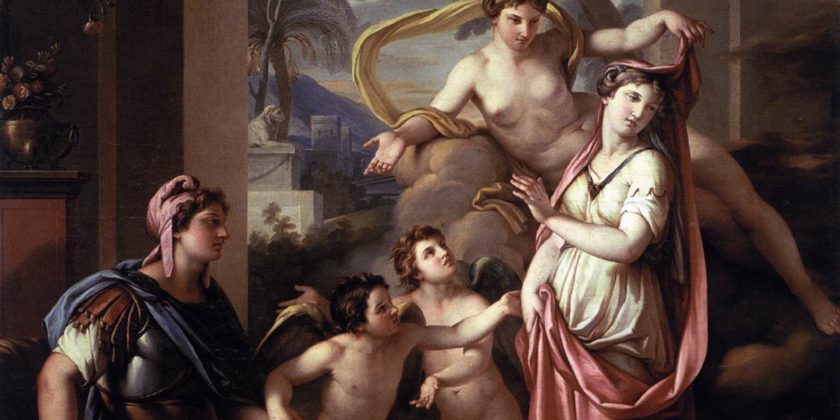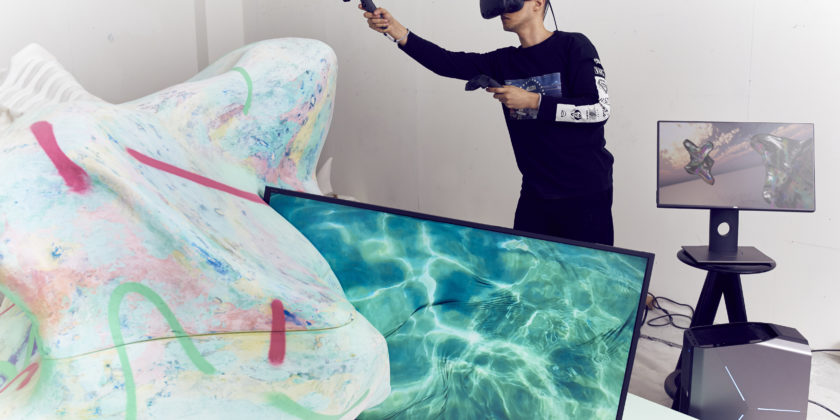From life: next generation artistic expression through VR
Step into an 18th century artwork and walk through the classical halls into to an ancient garden; fill the space around you with sparkling stars, pulsating coloured lines and flashing lights; explore masterpieces of ecclesiastical architecture that are transformed by simple hand movements.
“For the first time the Royal Academy will be working with artists exploring emerging technologies, which presents them with new ways to both observe and represent themselves and the world around them. From Life will reveal the creative process in making these new artworks, as well as opening up the exciting potential of future artistic applications of virtual and augmented reality.”
— Royal Academy of Arts
These are the latest ‘artistic’ experiences on offer in one of Britain’s most respected art institutions. As it celebrates its 250th birthday this year, Britain’s Royal Academy of Arts, working together with HTC Vive, is experimenting with next-generation artistic expression and design.
The Royal Academy (RA) is the UK’s longest-established fine arts institution and runs the oldest art school in the country. Founded in 1768 to promote the arts of design in Britain through education and exhibition, its latest exhibition From Lifecombines life drawing and virtual reality to create a new form of experiential artwork. Created on the digital platform Vive, artist Jonathan Yeo and Royal Academicians Humphrey Ocean, Yinka Shonibare, and Farshid Moussavi have produced innovative immersive works of art that move the discipline firmly into the 21st century.
What’s the objective?
From Life aims to trace the history of making art from life through the centuries to the present day, with new technologies demonstrating how the practice is evolving as artists examine new ways of making and seeing. Projects within the exhibition include building immersive experiences for visitors in the exhibition to ‘step into’, as well as creating the world’s first large scale 3D printed sculpture.
“This is an experimental project that explores everything from artistic process to technological evolution and creative collaboration. In a sense, From Life embodies what an artist-run academy was, is and might become.”
— Tim Marlow, Artistic Director RA
Victoria Chang, Director of the HTC Vive Arts programme, set up by the company to advance creation and appreciation of the arts. She explains that the project was designed to celebrate both life drawing and the special teaching techniques fundamental to the RA art school, showing how those techniques have continued to evolve right up to the present day.
“Giving artists VR tools to create artworks, this is what really interested the RA. They wanted to tell the full story of the practice of drawing from the earliest times,” she continues.
What technology does it use?
Vive is a first-of-its kind VR system developed in partnership by HTC and Valve, which retails for £759. Designed from the ground up for room-scale VR, users participate in immersive experiences through an adjustable headset with hyper real graphics, wireless controllers with HD haptic feedback and 360° absolute motion tracking.
The artists have used Vive technology and specialised content from Viveport – MakeVR and Google Tilt Brush – to explore new ways of observing and representing in cutting-edge technologies. As well as exploring architectural drawings and a tool pad of artistic effects, audiences can wander freely through Yinka Shonibare’s recreation of the 18th century neo-classical painting ‘Venus Presenting Helen to Paris’ by Gavin Hamilton, ending up in the sumptuous garden outside. This project is a collaboration with UK art and design studio Happy Finish.

Surmounting the challenges
Discussions on the project started in February 2017 and From Life opened in November of that year, with a run time of five months. Working with a short turnaround time for a project of this scale and scope was a challenge, acknowledges Victoria.
“We are a large company but our Vive Arts team is quite small and, as well as the RA exhibition, we were also running a big project in the National History Museum in France. Staging two major exhibitions simultaneously required a lot of resources, so we had to apply what we had very carefully.”
It was vital to get the project absolutely right and the entire process went through several months of testing before launch. The RA felt it was important to provide a full room-scale experience so that visitors could fully interact with the space. This created its own challenges around allowing each participant enough room to move freely, rather than, for example, building a seated experience.
“It was the first time the RA incorporated a VR element to a show on this scale,” explains Victoria. “They had to make very specific arrangements to accommodate audience involvement.”
How was it received?
The results were worth it though, as Victoria confirms – and on every level. “The artists were thrilled to work with new technology and are keen to develop this more. The gallery was delighted with the final results and the team enjoyed how the VR element was perfectly embodied within the wider exhibition.”
And the public loved it. Step into the RA on any given day and you’re quite likely to hear comments like “amazing”, “wonderful” and “absolutely stunning” as visitors to the gallery participate in the VR experiences.
Virtually Real
From Life followed an earlier ‘pilot’ VR project by the RA in 2017. Virtually Real was a week-long collaborative pop-up with HTC Vive and the academy’s contemporary art school that ran at the start of the year.
Here, using software such as Kodon and Google’s Tilt Brush, artists created installations for visitors to move through and interact with. Using HTC Vive’s playback technology, visitors could experience the creative process from start to finish and the artworks were also 3D printed and exhibited.
The project ran for a week and audiences loved it, encouraging the academy to incorporate its first VR element into the From Life full-scale exhibition later that year.
HTC Vive is also currently running an integrated VR experience in London’s Tate Modern, as part of the gallery’s Modigliani exhibition, where visitors can step into the studio where the artist lived and worked in the final months of his life.
What impact has it had on the art world?
“Since its opening, From Life has had a huge amount of press interest and coverage and a lot of articles have been written globally about how VR is making a positive impact on the arts sector,” says Victoria. She reveals that they have also seen a huge increase in interest from other cultural organisations who want to develop immersive technologies for their own projects.
The project is also available in the wider world, outside the on-site gallery experience, and can be downloaded for free to sample at home using a HTC headset.
Where could this go in the future?
“We’re going to see a prevailing trend for VR in visual arts in the future, using VR to both enhance exhibitions and create new contemporary artworks,” claims Victoria.

This trend will see the democratisation of the art world, believes HTC’s senior vice president of VR, Rikard Steiber. “I think virtual reality will change and expand our access to fine art. Rather than having to visit London or Paris to see works of art in a museum, you can bring that museum to everyone. You could look at the pieces in the museum, and then maybe visit the artists’ studio and understand the creative process, or maybe meet the artist and have that person explain what they were thinking or feeling. You can take the richness and understanding of a piece to a completely new level. It brings great opportunities for people who are excited about the arts and want to see more art.”
“We’re very passionate about democratising and accessing information, and with virtual reality you can democratise access to experiences. You can take people to places they’ve never been before. You can enable artists to create things that weren’t really possible before. At the same time, you as an individual could become anyone, go anywhere and create anything. What we want to be doing is helping these artists and curators reach a global audience, but also by reaching that global audience we will attract new audiences to global reality. So, we’re kind of accelerating the ecosystem around arts and virtual reality. That’s what we’re trying to do here.”
— Rikard Steiber, HTC
And while VR development is still in the early stage, the Vive Arts team explain it will become more and more compelling as it progresses. It will also move from being the solitary experience of From Life, to becoming more of a shared social event. “The technology exists to do this already,” says Victoria. “Now we just need artists to take it up and work with it.”